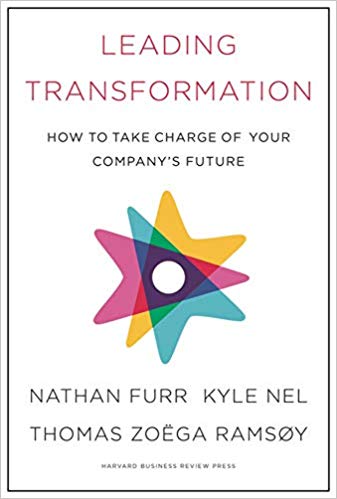Leading Transformation


Nathan Furr is a professor of strategy and innovation at the Insead Business School. Kyle Nel is the CEO of Uncommon Partners and formerly held the position of Executive Director of Lowe’s Innovation Labs, one of the book’s central case studies. Thomas Zoëga Ramsøy is the CEO of Neurons Inc. which is an innovation company that majors on neuroscience tools and techniques.
The business arena continues to evolve rapidly in ways which demand fresh innovative approaches that take account of emerging technologies and ever-shifting consumer patterns. At the same time major change efforts that fail to truly understand human fears, biases and habits will fail or be sub-optimal. Here, the authors draw on the tools of powerful storytelling, meaningful data and neuroscience to explore what they term ‘behavioural transformation’ as an influential framework for opening up new possibilities and facilitating change.
The writers define transformation in terms of seeing the possible value-creating futures for an organization and then overcoming all the different barriers to creating that future. They consider this one of the hardest things that leaders are challenged to do.
The essence of the book, therefore, is about taking charge of your company’s future and engineering a greater chance of success by working with appropriate tools that offer powerful insights and at the same time finding the right ‘uncommon partners’ to collaborate with along the route of discovery and implementation.
The primary case study is Lowe’s, a home improvement and hardware store company. Drawing on insights from behavioural economics, psychology, social psychology, applied neuroscience and innovation they majored on a three-stage approach they termed ‘behavioural transformation’. The three interrelated steps are: Strategic Narrative; Breaking Bottlenecks; and Future KPI’s.
In the first stage the emphasis is placed firstly on the power of storytelling in a framework that begins with a strategic narrative about possible futures. In the case of Lowe’s they chose the arc format of a science fiction comic to tell the future story. They then broke bottlenecks by carefully analysing language, habits and decision making while identifying what they term ‘overlooked abundance’ i.e. millions of customers. The future KPI’s were then developed based on an artefact trail of small prototypes and advanced neuroscience applications. Add to this the collaboration with uncommon partners such as Google and the transformation effort was in full swing.
The book then broadens their themes into a deeper analysis of change and transformation.
This book is a report of a process and tools that have appeared to work in companies such as Lowe’s, IKEA and Pepsi. Their goal has been to find ways to break the tendencies of incrementalism and risk aversion, while at the same time opening up minds to possibilities through iteration and exploration. They do a good job of broadening out each of their themes and have created a stimulating read that goes well beyond the ‘burning platform’ approach to major change.
Reviewed by Drew Watson: Drew is a Director of Drew Watson International Ltd and works in leadership and organization development. He was Group Head of Leadership Development at Standard Chartered Bank and is now also an Associate Fellow at Saïd Business School at Oxford University. www.dwiconsult.com
Title: Leading Transformation: How to take charge of your company’s future
Author/s Name/s: Nathan Furr, Kyle Nel and Thomas Zoëga Ramsøy
Publisher: Harvard Business School Publishing
ISBN: 978-1-633-69654-9
Publishing Date: November, 2018
Number of Pages: 231
Author Knowledge Rating: 1-5 (based on their years of experience, academic expertise in subject areas, and exposure to cross-functional thinking in the area)









































































Readability: 1-5 score(1=dense and v academic; 5=frantic; page turner)












































































Appropriate Length: (1=could have been written in 25% of the length;5=could have been longer)












































































Core Idea Value: (1=nonsense (or entirely esoteric); 5=game-changer)











































































